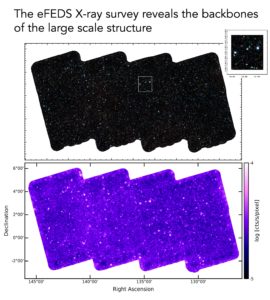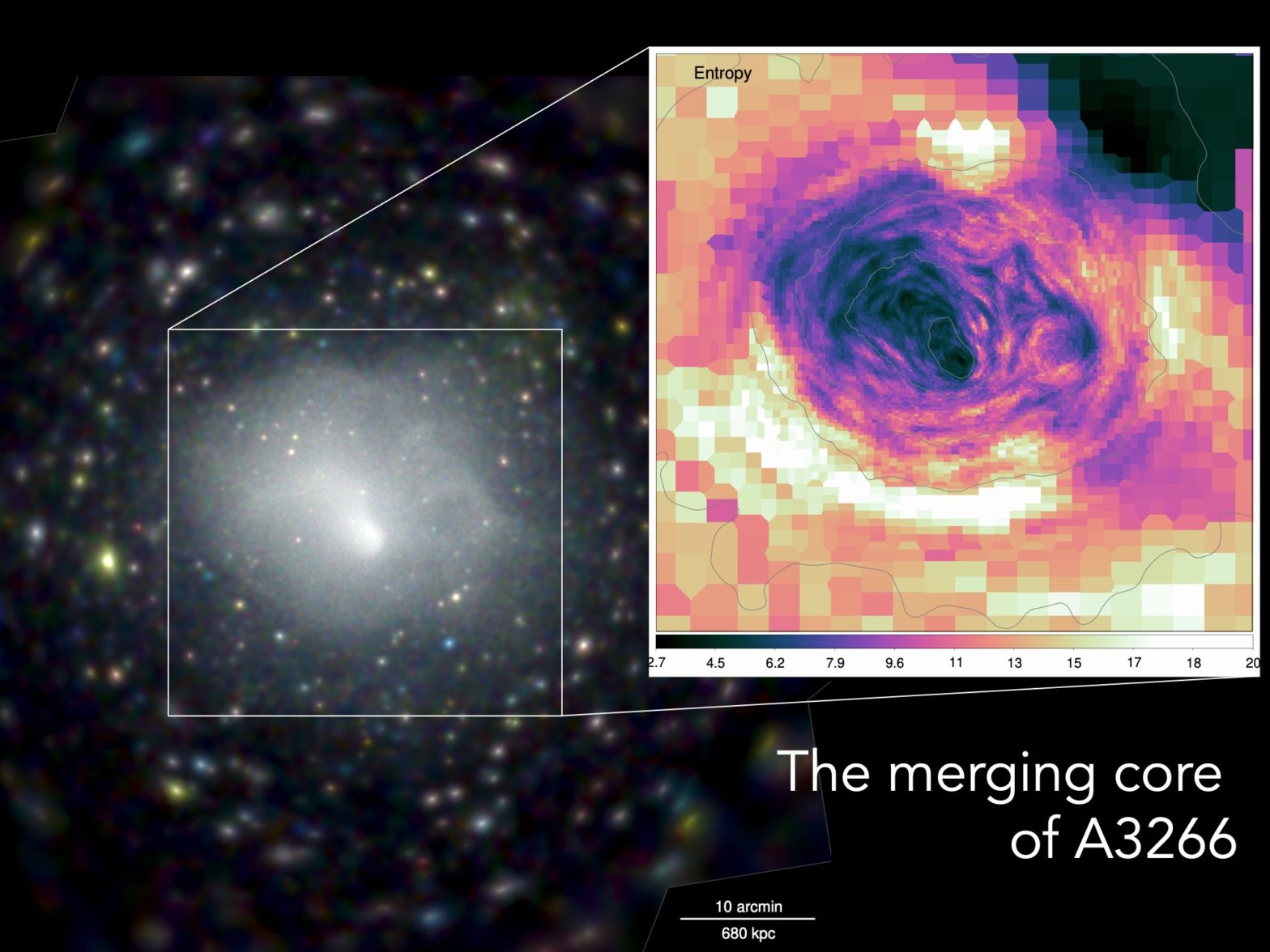P R E S S R E L E A S E
European Astronomical Society (EAS)
—————————————————————————————
28 June 2021
An appetizer to the all-sky banquet – first eROSITA X-ray data now released to the public
As announced during the 2021 meeting of the European Astronomical Society, the German eROSITA collaboration will release the first set of data taken with the eROSITA X-ray telescope onboard the SRG observatory. For the first time, astronomers throughout the world will have the chance to download and analyse data from this new powerful telescope. The Early Data Release will be accompanied by the publication of 35 eROSITA science papers by the German eROSITA Consortium on the arXiv preprint server, with these and more to be published in a forthcoming special issue of the journal Astronomy and Astrophysics.
“This is the first public release of SRG/eROSITA data,” points out Andrea Merloni, eROSITA principal investigator. “Since the start of observations with the X-ray telescope at the end of 2019, we have been impressed with the high-quality data, which have already led to numerous astronomical discoveries and breakthroughs. Now is the time to give astronomers worldwide a first taste of what is to come over the next few years. This is going to open up a whole new Universe of possibilities.”
The Early Data Release (EDR) observations were taken during the so-called ‘Calibration and Performance Verification Phase’, which lasted approximately from mid-September to mid-December 2019. Since then, the eROSITA X-ray telescope on-board the SRG spacecraft has been scanning the whole sky and producing sensitive X-ray all-sky maps, and it will continue to do so until the end of 2023. eROSITA is the first large X-ray focusing telescope optimized for surveys, thanks to its large field of view, high quality mirrors and sensitive CCD cameras.

© eROSITA collaboration, Brunner et al., Liu et al.
The EDR contains almost 100 individual observations of 29 distinct fields taken before the start of the all-sky scans. They cover a wide range of different astronomical objects, from galactic neutron stars to clusters of galaxies (see one example in Figure 2) and showcase the potential and versatility of the eROSITA telescope for imaging, spectroscopy and time domain analysis.
“Organizing these first eROSITA datasets in a comprehensive manner was a huge challenge”, says Miriam Ramos-Ceja at the Max Planck Institute for Extraterrestrial Physics (MPE), who is the main EDR coordinator. “First we had to gather and process the data in a uniform way, and then check and validate them to make sure they were of high quality.” In addition to the data itself, the MPE-led team will also make available dedicated software developed to reduce and analyze the eROSITA data. “We put a lot of emphasis on documenting all relevant steps taken to make the data and software easy to use by scientists all over the world,” adds Ramos-Ceja.
Among the datasets released to the public, there is one in particular that holds a special place: a mini-survey called “eFEDS” (the eROSITA Final Equatorial Depth Survey). Designed as a preview to the final all-sky survey, eFEDS covers uniformly a patch of about 140 square degrees of the sky (about 1/300th of the all-sky survey), providing a glimpse of what the whole extra-galactic sky will look like in X-rays after eROSITA completes its all-sky survey program in 2023. In just four days of eFEDS observations, eROSITA detected the astonishing number of almost 30,000 sources – more than can be found in any given contiguous X-ray survey field to date. The release includes not only the processed data, but also several catalogues of eROSITA sources describing their X-ray and multi-wavelength properties.
“We didn’t stop just with the X-rays – we have now combined the eROSITA X-ray data with UV, optical and infrared data from many different instruments both on the ground and in space,” explains Mara Salvato, eROSITA spokesperson and chair of the eROSITA follow-up working group. “The location of the eFEDS field was partly chosen because a large set of other observations are available from powerful telescopes across most of the electromagnetic spectrum. This step is crucial to classify the X-ray sources discovered by eROSITA and work out their physical properties. It’s exciting to see this all come together in eFEDS. It’s proof-of concept that we can do this for all the sources that that the all-sky survey will bring – though we still have a huge task ahead of us.”
The associated suite of 35 papers led by the German eROSITA Consortium mostly focus on the EDR observations, but also include a few exciting highlights from the ongoing all-sky survey. The objects under study range from stars and diffuse emission in our own Milky Way or the neighbouring Large Magellanic Cloud to Active Galactic Nuclei hosting supermassive black holes, and huge clusters of galaxies. “Apart from the ground-breaking science, another thing that makes me really proud is the contribution of female scientists to the effort, with 40% of the papers that accompany the data release led by women,” says Salvato. “The eROSITA collaboration will keep working towards making scientific opportunities available to all.”

© eROSITA collaboration, Sanders et al.
Along with everyone else, of course, COVID-19 has complicated matters for the eROSITA team. “Only six months after the start of eROSITA science observations, the global pandemic forced us to modify almost all aspects of our work,” says Andrea Merloni. “Even operating the telescope 1.5 million kilometers away had to be done from home. I’d like to think that the unique opportunity of working with a brand new ‘discovery machine’ has helped many of us to keep some sort of focus or balance – at least it did for me. eROSITA has given us many reasons to celebrate, and we are all looking forward to having a real party soon!”
The eROSITA EDR is available here from 29.06.2021: https://erosita.mpe.mpg.de/edr
Public eROSITA pages at MPE https://www.mpe.mpg.de/eROSITA
